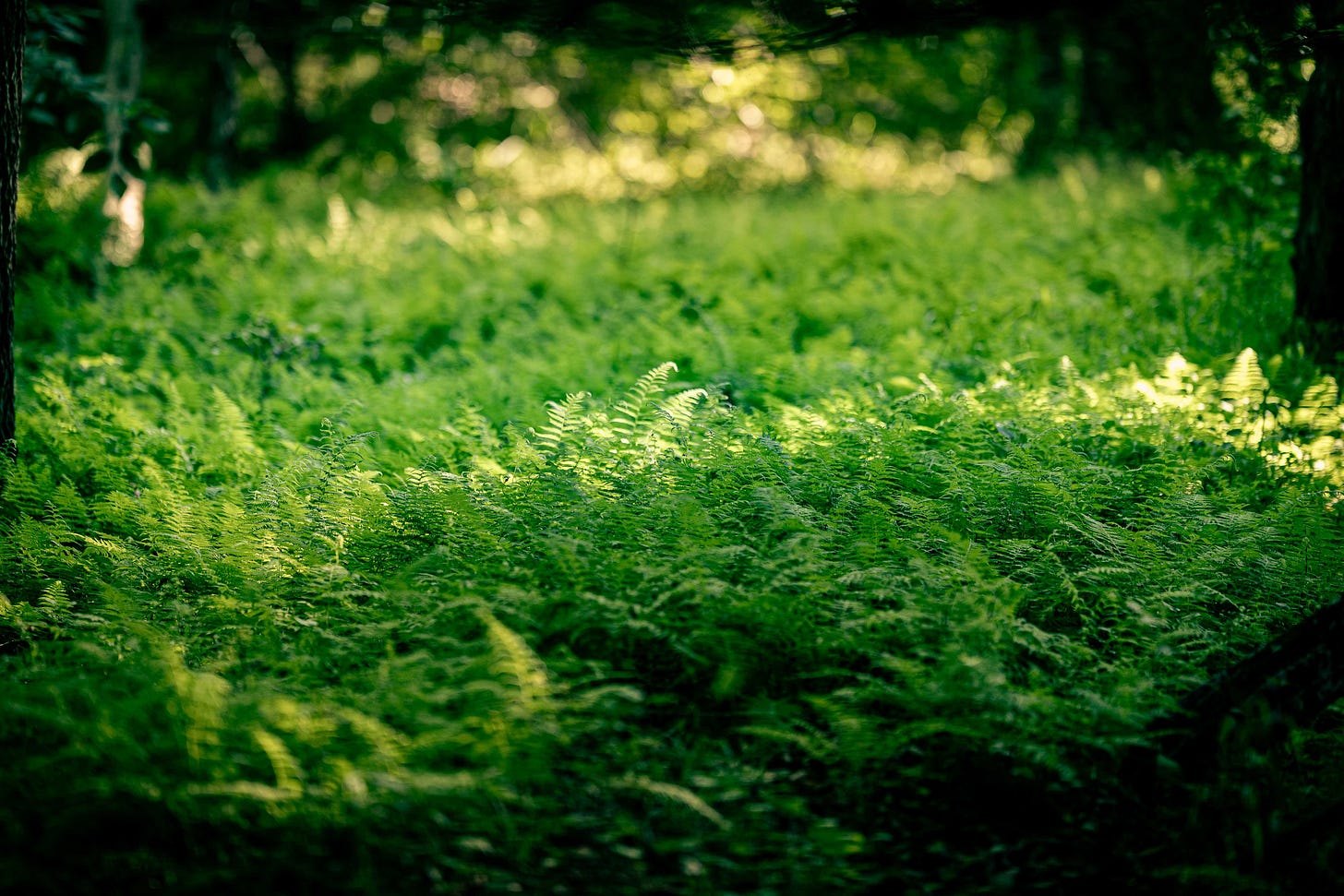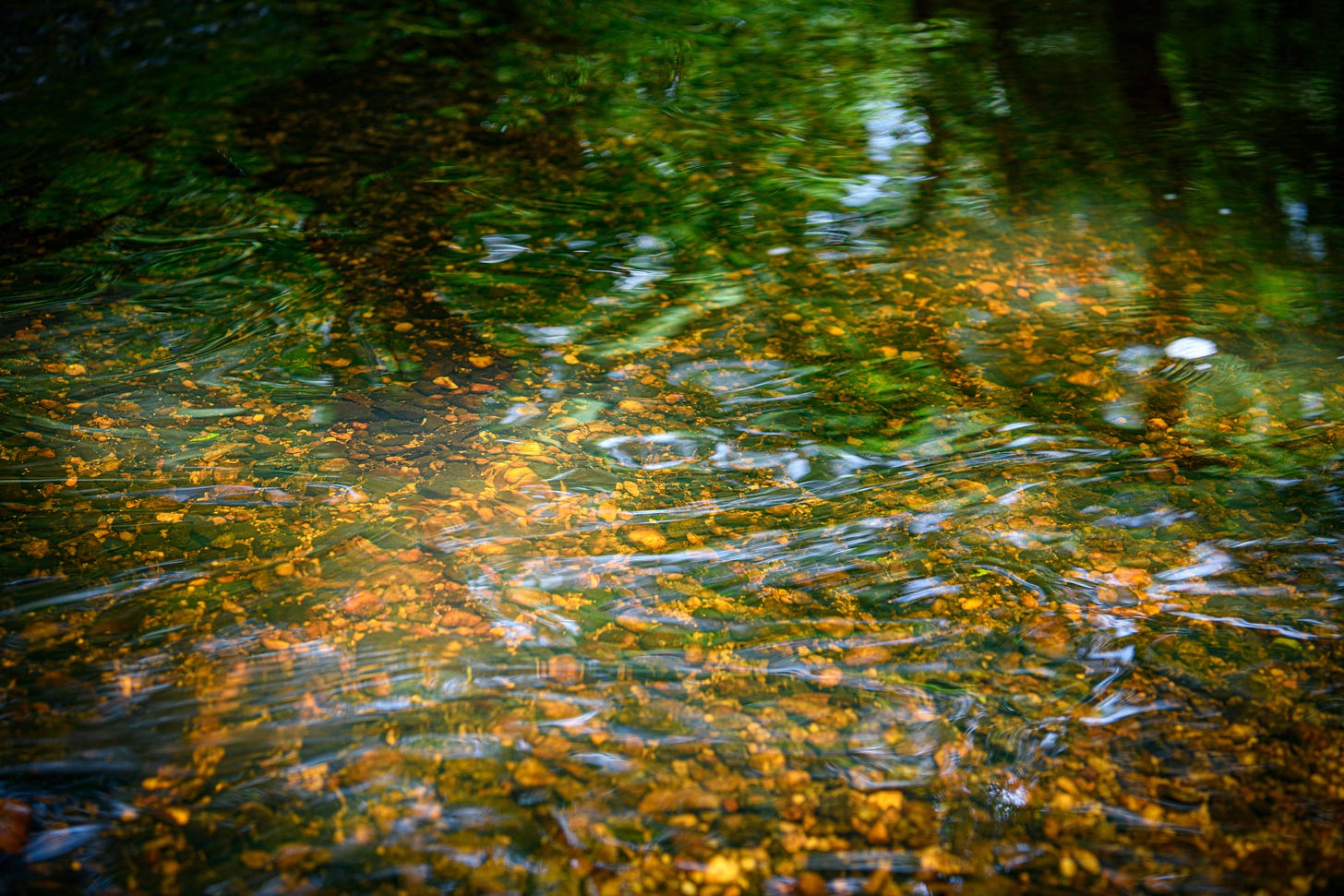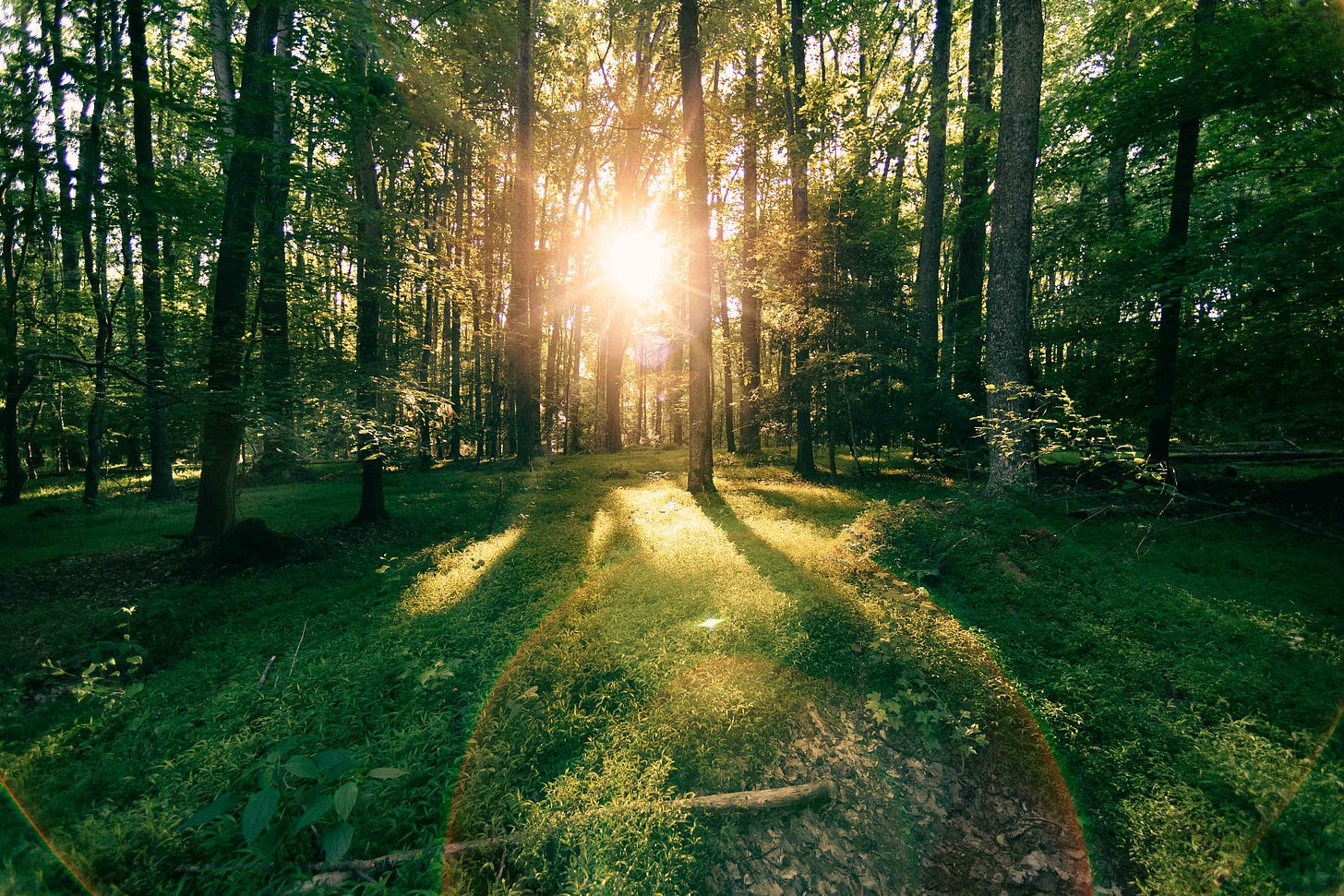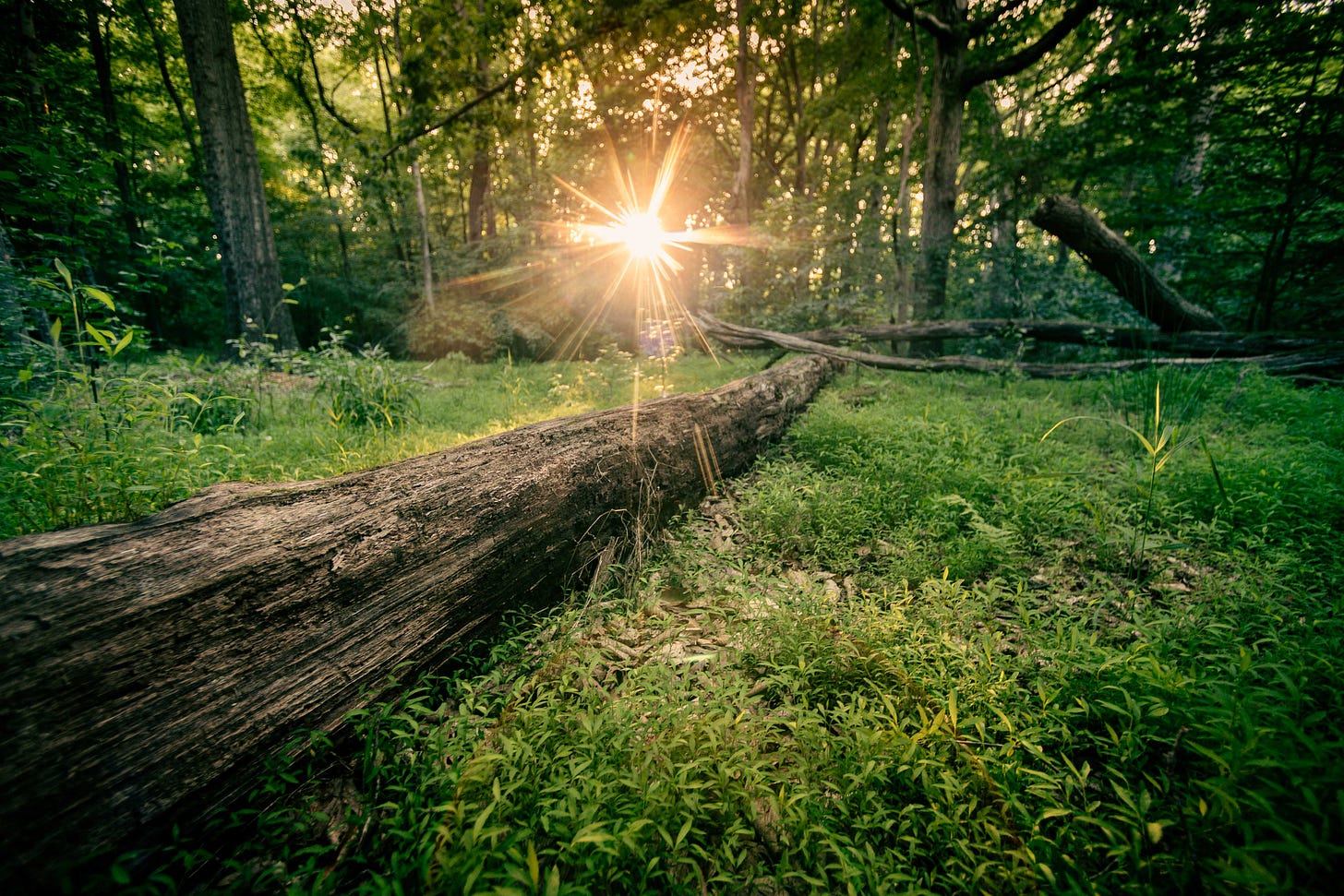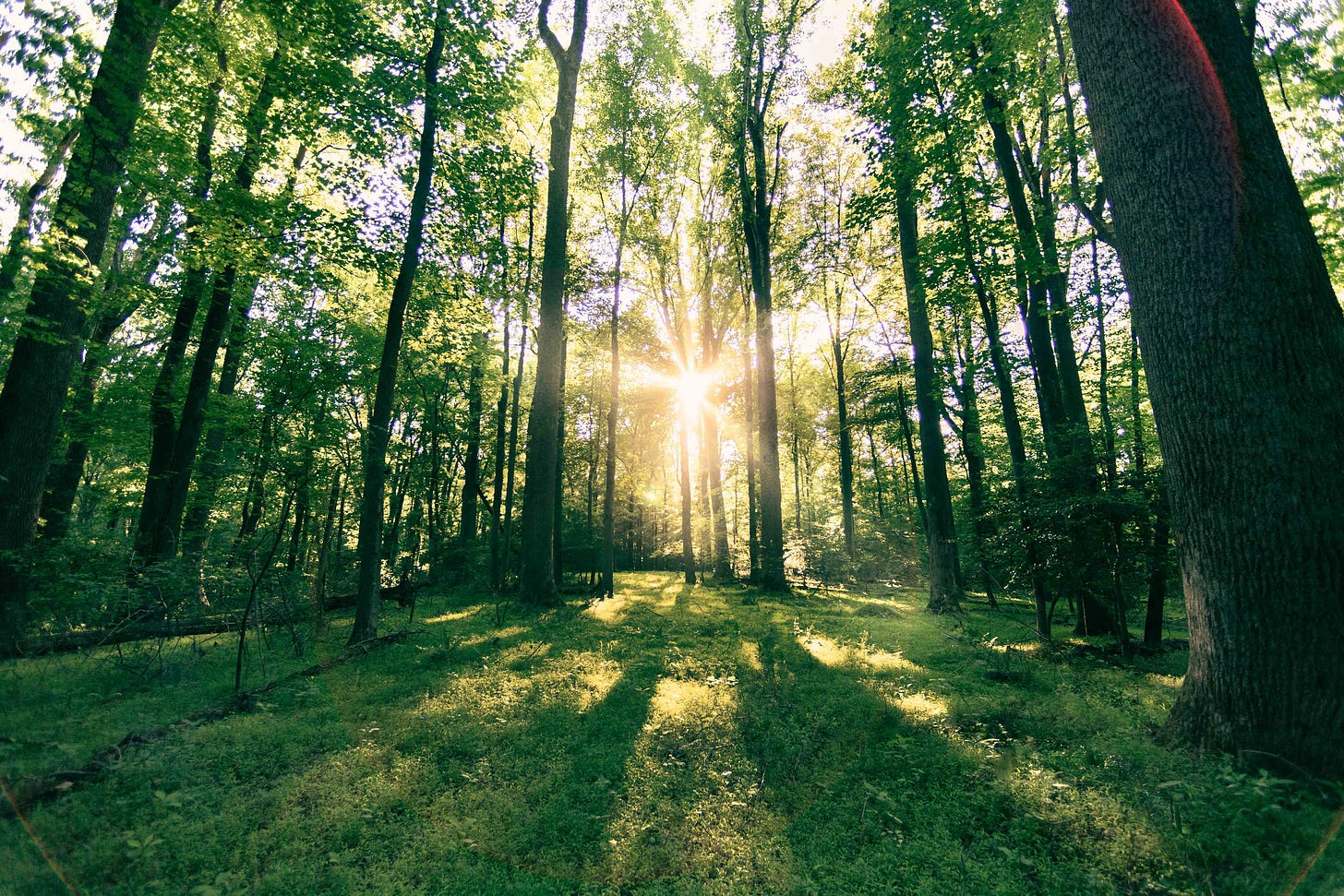The sun was already sinking by the time I stepped off the back deck and made my way down toward the woods. The air was cool, and the light had softened, casting everything in rose gold. A few early crickets had already begun their rhythm, their song carrying through the hush like distant bells.
I walked slowly, letting my feet follow the worn path that curved down our property into the woods. The forest floor has bloomed in the weeks since I last visited. Leafy ferns blanketed the ground and waved casually in the soft evening breeze. Tall Sweetgum and Maple trees whispered overhead, and somewhere nearby, a wood thrush sang its flute-like call into the stillness.
By the time I reached the bottom of the slope, the woods had fully gathered me in. The ground was soft and uneven beneath my boots, covered in damp moss and last autumn’s leaves. A doe stood on the ridge across the forest from me, ears alert, before bounding away with a flick of her white tail. I paused there for a while, letting dusk settle over me like a prayer.
This property has become something of a refuge to me these past five years—a place where the lines between memory and presence blur just enough to let me breathe. The world felt unmade and remade in the same breath—early summer in its tender becoming. Everything alive. Everything still figuring itself out.
Just like me.
The Light That First Found Me
When I first began working through recovery, revelations arrived like sudden bursts of light—huge, eye-opening affairs. It felt as though I had been stumbling through dense woods like these, tangled in brambles and thorn bushes, and then suddenly emerged into a clearing where sunlight poured down in golden beams. I’d make some connection—like why I had always craved the approval of others—so much that I became whoever people needed me to be, even if it meant abandoning myself in the process. Or when I came to see that my loneliness wasn’t just about being alone—it was about never letting anyone see the real me, only the version I thought they could accept.
Those moments of insight and revelation were glorious.
But my journey continued. And as it did, I found myself reentering the forest—into deeper shade, heavier cover, the paths less visible and more easily lost.
Over time, as I’ve grown in recovery, the questions have gotten harder—and the answers quieter.
A few years in, the brilliant sunlight moments are fewer now. More often, it feels like I am walking through a light fog, where I can see just far enough ahead to make out a path—thirty feet, maybe—but no farther. I keep putting in the work, keep carrying on the routines—daily meetings, 20 minutes of meditation, weekly therapy, reaching out to others to keep in touch. But the payoffs are less frequent.
Doubt is a constant presence in my life today.
Certainty is nonexistent.
The best I receive are whispers. Sometimes they’re clear. Sometimes I only sense them faintly, just enough to keep me moving forward.
If someone were to track my progress on a map, I’m sure it would show that I’ve gone in circles—maybe hundreds of times. Perhaps the circles are getting progressively larger, but still, I wander. I have big decisions to make—retirement, future work, relocating, kids going off to college. I have people offering me jobs. Opportunities float past like dandelions on the breeze, tempting me to snatch or chase them down. But something tells me to wait. Something tells me to listen for the whispers.
I continue to meander through the woods as twilight settles in. It’s mid-May in southern Maryland, that brief, glowing window when the air is warm but not heavy yet, and everything green feels like it’s still unfolding. The tall ferns brush against my legs, soft and delicate like little velvet fingers waving in the breeze. I duck beneath low branches and step across patches of spongy moss along the banks of our creek.
The creek winds quietly through the lower edge of our woods, no more than six feet across at its widest, but alive with movement and clarity. Its water is always crystal clear—so clean you can see straight through to the bottom, where a mosaic of smooth, colorful stones glints beneath the surface. There are streaks of quartz, milky and white, tucked between bands of slate gray, rust-colored jasper, and the occasional chunk of mica catching the light like a mirror. Rounded pebbles in shades of amber and deep green are scattered across the creek bed, polished smooth by time and flow.
The water is icy cold, no matter the season—so sharply refreshing that it stings your fingers if you dip them in too long. It’s spring-fed, most likely, pulled from somewhere deep underground and carried here in a quiet ribbon of life that never seems to dry up. Even on the hottest summer days, the air above the creek stays cool and crisp, like the forest itself is exhaling. The banks are soft and moss-lined, overhung with ferns and the gnarled roots of trees that have held their ground for decades. The creek doesn’t roar or rush—it murmurs. It hums along its stones like it’s remembering something ancient.
A woodpecker knocks in the distance. I pause now and then, not because I’ve arrived anywhere, but because something—some sound, some scent, some feeling—asks me to stop and pay attention. I don’t know what I’m looking for. Maybe I’m not looking at all. Just wandering.
Fog, Circles, and the Pull of the Unseen
There is one thing that is very different about my journey these days—something that gives me a quiet sense that I am indeed progressing: I am no longer looking to others for reassurance.
In the past, when I’d be uncertain of anything, I’d run to people. I’d tell them of my struggles in hopes they would tell me what to do. Or I’d lay out what I thought was the map and ask them to check my coordinates. I needed someone to confirm that I was doing it right, that I was on track, that I wasn’t wasting time or headed in the wrong direction. I didn’t want to be alone with my questions. I wanted someone to make the doubt go away.
Am I heading in the right direction? How does this sound to you? Do you think I am on track?
And that was necessary for a season. I needed the constant reassurance of people who truly loved me to encourage me forward, else I would have retreated to safer ground and given up the journey altogether.
It is amazing how freely we accept miserable conditions out of sheer familiarity, isn’t it?
Because often the familiar feels safer than wandering.
Choosing the Voice Within
I recently wrote about choosing clarity over certainty. Even when the familiar is slowly suffocating us, or dulls us, or drains us and keeps us small, there’s a strange kind of comfort in predictability—even if that predictability is pain. Allowing ourselves to be led by an inner clarity, on the other hand, requires trust. It asks us to let go of the map. To walk without knowing where the path leads. To believe, somehow, that forward exists—even when we can’t see it.
These days, I find myself more comfortable with wandering than I used to be. I am not looking for people to confirm or validate my map. I am learning to listen to my own inner voice—the same voice I have been ignoring all of my life.
I used to think my feelings were not to be trusted. After all, I am a musician. I am an artist. I am temperamental. My feelings are variable. They come and go, and they are very intense. And for years I have had many people reinforce the idea that my feelings were not trustworthy, that I should listen instead to some distant authority or perhaps the wisdom of my elders. I come from a long tradition that sees feelings as not only untrustworthy guides, but maybe even something deceitful—like sirens luring sailors toward the rocks. Beautiful, seductive, and ultimately destructive if followed too closely.
To be fair, if I made major life decisions in the moment, I’d almost certainly be unemployed and destitute. The only way I have managed to achieve what I have achieved is that I’ve learned to pause. To wait. To sleep on things before making any decision that could cost me money, time, or relationships.
But these past few years, I have been discovering that there’s a difference between pausing and silencing or ignoring.
I never realized just how much I had been taught to distrust my feelings until I started really paying attention to how often I apologized for them—how often I second-guessed a hunch, dismissed a gut instinct, or wished and hoped for someone else to give me permission to do what I already knew deep down.
And the bitter truth I have discovered is that I have been taught to distrust myself—almost like I’ve been taught how to gaslight myself. To question my instincts. To doubt my perceptions. To explain away my pain. I learned to override my inner voice before I even knew it had one. And after years of doing that, it became second nature to assume that someone else must know better than I do what’s right for me.
I am only now beginning to see that my feelings—even the intense ones—are not enemies. They are signals. They point to something worth noticing. And while I may not act on them immediately, I no longer dismiss them outright. I let them rise. I let them speak. And then I wait to see which ones stay.
I am fortunate to have people in my life who have tremendous clarity. Take my friend David, for example. When I try to explain to him how I’m thinking through an issue, he often tilts his head, puzzled, and then asks the most stunningly clear questions—the kind that pierce straight through the fog of my self-induced confusion.
People like David can do this so easily because they weren’t raised to question themselves. They don’t carry the same baggage I do—the old, inherited voices of confused authority that still drown out my own steady knowing.
They were taught to think clearly, to trust their inner compass, and to heed its guidance.
And heed it they do. Their lives are amazing because of it. And they are the most peaceful, centered, self-assured people I know. So when they speak, I listen.
The Forest Is Not the Problem
So although doubt is my constant companion today, and I battle fear on a daily basis, I am not rushing out to seek validation. I think that is why it is so easy for me to publish here on Substack.
I could never have written about any of this before because my writing would have come with needs attached. Between each sentence would be hidden messages screaming to be heard.
Please tell me I am doing the right thing!
Please agree with my point of view!
Please encourage me! For the love of god, I am so scared!
Do I feel like that today? Of course I do!
But I find myself seeking less the support and guidance of others, and listening instead to what my heart is telling me. I am willing to listen—and trust—that inner voice I doubted and silenced for so long. And amazingly, every time I do that—every time I meet a wave of fear with a calming breath and a return to my own center—I grow a little bit more.
I don’t get the big ‘aha!’ moments much anymore—the kinds that made my therapist cheer or my friends tear up. These days, it’s more like quiet whispers. A small piece of the path becomes visible. The fear loosens just a bit. The clarity sharpens just a touch. Doubt feels less like an enemy to escape and more like a traveling companion I’ve reluctantly accepted.
I used to think of recovery like this forest—a dark, tangled labyrinth I would one day emerge from into the clear.
But today, walking through my own woods, I’m realizing that metaphor doesn’t quite fit.
Because standing here beside my stream, surrounded by trees and ferns, I feel something vital settle in me:
This forest of doubt may always be the terrain of my life.
Not something to escape or survive.
A place to walk with wonder.





